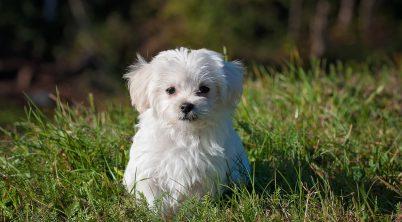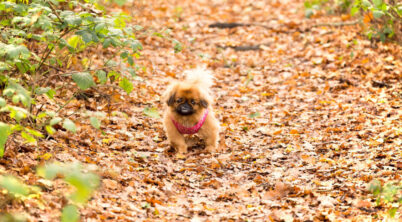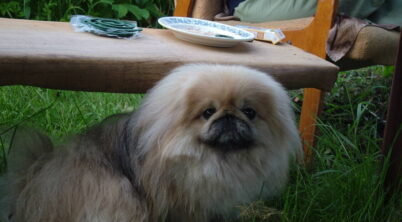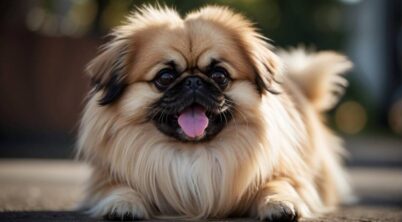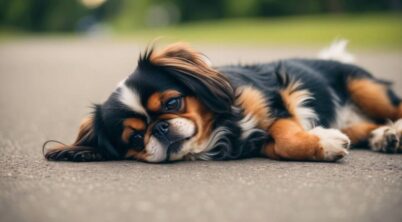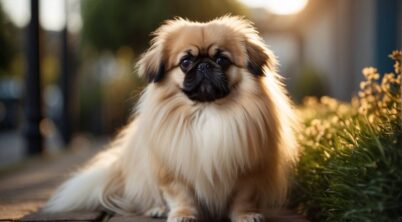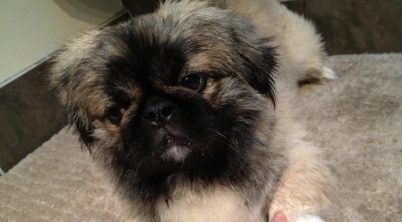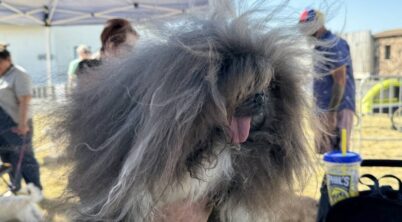The Pekingese, a breed of toy dog originating from ancient China, carries with it a storied history as regal and luxurious as their appearance suggests. Often referred to as the “Lion Dog” due to their resemblance to Chinese guardian lions, these dogs were favored by Chinese royalty and were a fixture in the Chinese Imperial court. Their long, flowing coats, flat faces, and bold demeanor are characteristic of the breed, making them a distinctive choice for many dog enthusiasts who appreciate family pets with historic grandeur.
However, the breed’s physical characteristics contribute to a propensity for developing a noticeable odor. The Pekingese has a thick double coat that, while aesthetically pleasing, can trap dirt, oils, and moisture, leading to an unpleasant smell if not properly maintained. Their facial structure, with its deep skin folds, can also harbor moisture and bacteria, further contributing to potential odor issues. This aspect of Pekingese care is important for prospective and current owners alike to consider, as it has implications for the dog’s health and the household’s comfort.
Table of Contents
Pekingese Dog Odor
Factors contributing to the Pekingese’s odor can vary. One common issue is the breed’s long, dense coat, which can trap odors and dirt. Proper grooming, including regular brushing and bathing, is essential to prevent matting and maintain a clean coat.
The Pekingese’s distinctive facial structure can also lead to odor issues. The folds around their face require routine cleaning to prevent fold dermatitis, which is characterized by redness, sores, and an unpleasant smell.
Here are some common reasons for a Pekingese’s odor and tips to manage them:
- Heat and Humidity: A Pekingese can develop a stronger odor if living in a warm, moist environment, which causes their dense fur to retain moisture.
- Tip: Air-conditioning and dehumidifiers can help maintain a cooler, less humid environment.
- Facial Folds: The facial structure can lead to accumulation of moisture and bacteria.
- Tip: Clean the folds regularly with moistened cotton to prevent infections and odor.
- Natural Odor Intensification: All dogs have a natural scent that can become stronger due to various factors, such as diet or health issues.
- Tip: Consult a vet for dietary adjustments or health check-ups.
- Grooming Needs: Without consistent grooming, a Pekingese’s coat can harbor dirt and bacteria.
- Tip: Frequent brushing and occasional trimming are necessary, particularly around the hind end.
Cleanliness and regular vet check-ups play crucial roles in controlling odor. Owners must be diligent with the grooming routine to keep their Pekingese smelling fresh.
Breed Characteristics
The Pekingese is a toy breed, recognizable by its stunning double coat that encompasses a myriad of colors such as black, white, cream, red, fawn, tan, and gray. They are notably characterized by a lion-like mane that frames their face, exuding a regal appearance. A fully grown Pekingese’s size is quite small; however, their thick fur can give the illusion of a larger frame.
Appearance & Size:
- Height: typically between 6 and 9 inches
- Weight: can be up to 14 pounds
- Coat: a luxurious, long, straight double coat requiring regular grooming
- Coat colors: diverse, including black, white, cream, red, fawn, tan, and gray
The breed’s face features a short snout, a prominent feature of brachycephalic (flat-faced) breeds. The Pekingese’s distinct rolling gait supplements their stately presence. This breed often sports deep facial folds and wrinkles, hallmarks of their breed’s heritage and unique look.
In terms of temperament, the Pekingese is known for its intelligent, independent, and loyal nature. While they can be affectionate and social with their families, they also carry an air of dignity, akin to the royal courts where they were once companions. Their regal demeanor often encompasses a surprisingly effective watchdog ability. Despite their compact size, the breed is confident, alert, and protective, showing a level of friendliness that blends well with their innate caution around strangers. However, their independence can sometimes translate into stubbornness, necessitating an owner who approaches training with patience.
Grooming and Coat Care
Effective grooming and coat care are pivotal in managing and preventing foul odors in Pekingese dogs. This breed’s dense double coat requires diligent maintenance to ensure hygiene and reduce shedding, which can contribute to unpleasant smells.
Regular Grooming
Regular grooming is the cornerstone of odor control for a Pekingese’s coat. It is essential to brush the coat several times a week to remove dirt and loose fur that can harbor bacteria. Use a bristle brush or a long-toothed comb specifically designed for double-coated breeds, thoroughly working through the layers of fur.
- Tools Needed:
- Bristle brush
- Long-toothed comb
- Grooming scissors (for trimming)
Trimming around the feet, eyes, and muzzle should be done with care, as these areas can collect debris and moisture, leading to a build-up of odor-causing bacteria.
Shedding Management
The Pekingese sheds seasonally and managing this shedding is key to controlling odor. Brushing more frequently during shedding seasons — typically spring and fall — helps to remove the dead hair and dander that can lead to a smelly coat.
- Shedding Seasons:
- Spring
- Fall
Employing the right grooming tools can help to catch the undercoat and reduce the amount of loose hair, keeping the home cleaner and the dog’s coat less prone to odor absorption.
Bathing Techniques
While regular grooming can minimize the need for frequent baths, a Pekingese should be bathed every few months, or as needed when the coat becomes notably dirty or starts to emit a foul odor. It’s important to use a dog-specific shampoo that is gentle on their skin to prevent irritation.
- Bathing Frequency:
- Once every 3 to 4 months
- More frequently if the dog becomes particularly dirty or smelly
To bathe a Pekingese effectively:
- Wet the coat thoroughly with warm water.
- Apply dog-specific shampoo, taking care to avoid the eyes and inner ears.
- Rinse thoroughly, as residual soap can cause itching and odor.
- Pat dry with a towel and, if necessary, use a hairdryer on a low, cool setting to fully dry the coat, especially the dense undercoat.
Maintaining a clean environment for the Pekingese to sleep and rest in can also help to prevent the return of foul odors between grooming sessions.
Health and Well-Being
The health and well-being of a Pekingese dog can be influenced by a variety of factors, including common health issues, diet, and exercise needs. They require attentive care from their owners to maintain a good quality of life.
Common Health Issues
Pekingese dogs may be predisposed to certain health problems due to their physical characteristics. Regular check-ups with a veterinarian are crucial to detect and manage these concerns:
- Respiratory Issues: Due to their short noses, Pekingese can experience breathing difficulties.
- Eye Problems: Their prominent eyes make them susceptible to conditions like corneal ulcers.
- Skin Infections: These can occur if they are kept in hot, humid environments.
- Dental Issues: Good dental hygiene is important to prevent tooth and gum diseases.
- Ear Infections: Routine cleaning is essential to prevent infections due to their ear structure.
Diet and Nutrition
Appropriate diet and nutrition are vital for a Pekingese’s health maintenance:
- Obesity Prevention: Pekingese dogs need a balanced diet as they’re prone to weight gain.
- Caloric Intake: This should match their daily energy expenditure to avoid diabetes and other weight-related health issues.
Exercise Needs
A Pekingese dog’s exercise needs must be met to prevent obesity and to maintain overall well-being:
- Daily Walks: Aim for two 20-minute walks each day.
- Playtime: Engage them in games like fetch or activities at the dog park. Regular exercise supports not just physical health but also mental stimulation for a Pekingese.
Breed Specific Concerns
In addressing the concerns associated with the Pekingese breed, particular attention should be given to its breeding background and how it adapts to various environments.
Breed Group and History
The Pekingese falls under the Toy group, originating from ancient China. Historically, they were companions of the Chinese imperial family in Beijing and were highly valued for their lion-like appearance, which was believed to be an homage to the lion in Buddha legend.
- Origin: China, specifically Beijing
- History: Bred for Chinese nobility, esteemed in ancient China
- Buddha link: Symbolic representation of the lion
Environmental Adaptations
Pekingese have certain adaptations that allow them to thrive in an indoor environment, making them well-suited for apartment living. However, they require a cool and comfortable atmosphere, as their thick fur can make them prone to overheating.
- Apartment living: Well-adapted, ideal for indoor living spaces
- Cool environments: Necessary to prevent heat discomfort due to dense fur
* Banner photo by Eli Christman, cropped | Some rights reserved

